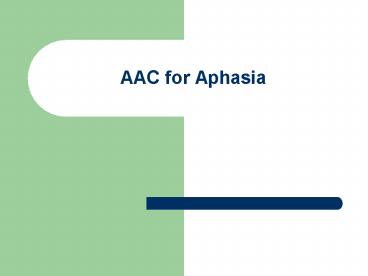AAC for Aphasia - PowerPoint PPT Presentation
1 / 20
Title:
AAC for Aphasia
Description:
AAC for Aphasia Contour of a conversation Greetings Small talk Information sharing Wrap-up and farewell statements Communication patterns of elderly persons Negative ... – PowerPoint PPT presentation
Number of Views:537
Avg rating:3.0/5.0
Title: AAC for Aphasia
1
AAC for Aphasia
2
Contour of a conversation
- Greetings
- Small talk
- Information sharing
- Wrap-up and farewell statements
3
Communication patterns of elderly persons
- Negative image
- Slower word recall.
- More ambiguous noun usage.
- Reduced variability in production of verb tenses
and syntactic structures. - Smaller active vocabularies.
4
- Positive perspective To attribute the age
difference to variations in - Social roles
- The contexts in which people live and interact.
5
Communication patterns of elderly persons
- Small talk proportion
- Young adults 40
- Elderly 65-74 31
- Elderly over 75 26
6
Communication patterns of elderly persons
- Storytelling proportion increases with age.
- Elderly adults tell stories
- To transfer cultural traditions.
- To instruct younger individuals.
- To establish social members with peers.
7
Communication patterns of elderly persons
- Time-frame
- 65-74 over 75
- Future 13 10
- Present 48 45
- Past 39 45
8
Communication patterns of elderly persons
- People and activities
- Women talk about 65-74 over 75
- Family 28 less
- Friends 13 more
9
Communication patterns of elderly persons
- People and activities
- Elderly talk about
- Games 6
- Food 8
- Household relationships 6
- Work 5
- Family life 4
10
Roles of AAC
- Replacing
- Supplementing
- Scaffolding
- Natural speech
11
AAC techniques across severity range
- Lindblom (1990) model of communication mutuality
- A triangle
- The vertical axis information provided through
speech only. - The horizontal axis information provided from
AAC techniques.
12
AAC techniques across severity range
- Mild aphasia
- Typically rely on speech, yet experiencing anomia
or word retrieval difficulty. - May need a word list to read or to be read for
cuing.
13
AAC techniques across severity range
- Moderate aphasia
- AAC can support (supplement or replace) residual
speech and enable delivery of more comprehensive
messages. - Using gestures
- Pointing to an item in a remnant book
- Writing words
- Drawing pictures
14
AAC techniques across severity range
- Severe aphasia
- Little speech and more relying on AAC and a
supportive partner - Using picture or photograph books,
- Referring to maps,
- Drawing simple pictures or diagrams,
- Using physical space.
15
AAC techniques across severity range
- Receptive impairment
- To help aphasic individual grasp a topic of
conversation - Point to pictures, maps, objects,
- Use gestures,
- Draw simple pictures or diagrams.
16
Attitudes toward AAC use
- Lasker (1997)
- Three groups listened to an aphasic telling
stories using - Unaided natural speech,
- digitized speech output device,
- A communication notebook.
17
Attitudes toward AAC use
- Most competent, most effective, most
understandable comfortable and willing to
interact digitized speech output. - Least competent, least effective, least
understandable unaided natural speech.
18
Attitudes toward AAC use
- The most preferred system
- Digitized speech output 60 peers 33 SLP 37
family. - Natural speech 46 SLP family 43.
- The least preferred system
- Natural speech 77 peers 17 SLP family 33.
19
Specific AAC techniques
- Written choice communication
- Gestures
- Remnant books
- Electronic devices
- Drawing for expression
- Partner drawing
- Communication book
20
Specific AAC techniques
- Alphabet board
- Word dictionary
- Picture/photo dictionary
- Instruction card for listeners
- Rating scales
- Eye gaze































